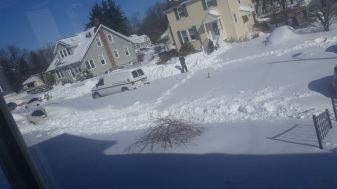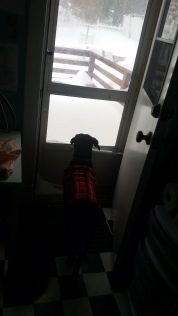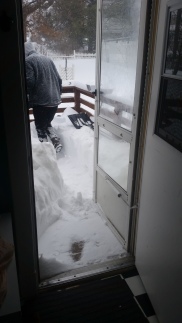Who Makes Your Snowday Possible?
 A post by Women’s Center staff member Daniel Willey
A post by Women’s Center staff member Daniel Willey
Earlier this semester, as I’m sure you all remember, we got hit (bombarded, pelted, buried, whatever) by winter storm Jonas. BWI airport recorded almost 30 inches of snow and the wind blew the icy flakes sideways into drifts best navigated with a harness and rope or a tunneling machine.

The sea of snow outside my house in Halethorpe on Sunday
Baltimore shut down the Light Rail, MARC, and buses for almost a week — only the fourth MTA shutdown in the last 40 years. My roommates and I braved the grocery store on Thursday night before the storm hit and it was a nightmare. I thought my mom was just being a mom when she texted to warn me that all the bread was gone. Some impatient man in a business suit chased me away from my parking spot at the Giant by honking his horn repeatedly so he could swoop in and take it. People were getting nasty.
Now, I’m used to this kind of snow.

Our dog Raven wondering how she’ll ever get out to pee
Having grown up in the mountains in Western Maryland, I’ve seen my fair share of snow and ice storms. But I’ve never experienced it in an urban setting and I’ve definitely never been old enough to be the responsible snow survivor before. It got me really thinking about what it means to have a snow day and how the local and state government reactions to something like Jonas has a lot more to do with social issues and inequality than you might think.
The MTA shutdown is what got me thinking first. If you’ve ever taken a Baltimore City bus you know our transportation system is flaky at best. But you probably also know how many people rely on the MTA every day for school and work and errands and everything else. When it shut down, all those people suddenly lost that essential piece to their everyday goings-on. And sure, the first day or so when nobody could leave their homes anyway may not have mattered. But the people who do the hourly and low-wage jobs that are essential to the running of any city had to get to work on Sunday. And Monday. And Tuesday. And Wednesday.
The MARC and Light Rail didn’t start back up until Wednesday (on a limited schedule) and even though there were buses on Monday, there weren’t very many and it was a total free-for-all in terms of scheduling for several days. While we UMBC students and many people in office or management or government jobs (positions with salaries and benefits and paid leave) had half a week of snow days, the snow plow and bus drivers, food service workers, maintenance and road workers, hotel staff, emergency responders, retail workers, grocery store clerks, pharmacists, and nurses (and the many many others who rely on pay from every hour they can get their hands on) made the trek to work with basically no transit system.

Well, she got out but she is not happy about it
And then I thought about my horrible grocery store experience. I thought about the brave souls running the checkout aisles and managing the rapidly depleting inventory. I thought about all the families without cars or living in food deserts who would struggle to get provisions for the coming storm. What about disabled people or older adults who couldn’t hustle to the store and back in time? I thought about the low income families who are unable to spend large amounts of money at once to stockpile supplies or those who had run out of food stamps because it was the end of the month. What about the people whose heat was shut off? Or those living in abandoned houses or their cars or in the tents on MLK Blvd?
When I picked my boyfriend up from work early on Friday (because there was no bus– surprise!) he said, “The people who are running around and freaking out right now are going to be fine.” And he was right. We had the money to stock up on food. We could afford to live in quality, well-maintained housing with good heat and a solid roof. They had plowed out our whole neighborhood by Sunday afternoon. A friend of mine who lives on Guilford Ave a few blocks outside of Station North said the road was plowed a few blocks down from where it connected to North Ave, but then it just ended. There was no dead end, no cars blocking the street, nothing to indicate it would make more sense to stop there than to continue down into the poorer or residential areas down the street. The lines of where plowing happened first and last show a very clear indication of what areas of the city are important and why.
Taking a snow day is a luxury. Getting a snow day means that if you don’t have a salaried position with paid leave, you have to lose pay for lost hours. Sometimes it means making a choice between braving a dangerous commute and earning your next meal — or even just keeping your job (and if there’s no public transportation, the low-income portion of the 30% of Baltimore residents without cars can’t get to work). A snow day is made possible by people who can’t take a snow day.
Getting a snow day can be fun for some students, but many low-income students rely on free school meals. For some students, this is their only steady source of nutrition.
On the Tuesday after the storm, only female Senate members and their female staff showed up to work on Capitol Hill. Proceedings had been postponed until Wednesday, but someone had to be there to make an official motion to postpone the Senate in order for that to happen. Those people were women. Sure, some may have been truly snowed in but, like I said, a snow day is made possible by people who didn’t get one.
The way a city handles a snowstorm is a social justice issue because socio-economic status is a major factor in the health, safety, and well-being of low-income and at-risk populations. So, think about it. What (and who) made your snow day possible?
Posted: February 8, 2016, 12:08 PM